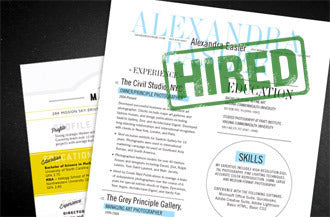Blog
How to market your transferrable skills
It’s no secret that switching careers is tough. How can you convince someone you have exceptional skills as a manager when you have only worked as a salesperson? But today more than ever, transferable skills are extremely valuable to employers.However, career transition can be done and achieved successfully. All you have to do is understand what transferable skills are and how to incorporate them into your cover letter, professional resume and LinkedIn summary.
Your transferable skills are the attributes and abilities you have gained from your career, volunteer or social activities. The way you present your skills to potential employers and professional networks will set you apart from other job seekers.
A key transferable skill to an employer today is leadership. Many people already possess this skill in one form or another yet they may not recognise it in their current job. If you can you assess the importance of tasks, identify if a task is really necessary, or step back and analyse problems, then you possess the transferable skill of leadership.
Here’s how you can identify and market your transferable skills to stand out from the crowd:
• Write a list of your soft and hard skills gained from your current job and volunteer activities.
• Assess those skills against your new career goal/s.
• Research job advertisements and job descriptions related to your new career goals and note the words used to describe your transferable skills.
• Update your resume or Curriculum Vitae (CV) and incorporate the keywords used to describe your transferable skills.
• Clearly articulate examples of your transferable skills in your resume or CV and how these will enable you to seamlessly transition into the new job.
• Use the heading “Related Skills” on your resume or CV to highlight transferable skills relevant to the job.
• Engage a resume writing service provider for a professional looking resume or CV.
You want your professional resume or CV to demonstrate you possess the skills and abilities required by a future employer. So, it is important to ensure that you include relevant examples to market your transferable skills.
- Author Nicole C
- Category skills
- Comments 0
Five tips for creating a video resume
Creating a video resume can be nerve-wracking. Instead of hiding behind your achievements on paper, you have to show yourself. But, whether you like it or not, many companies now include a video resume as part of the application process. Get yours right with these five tips.

1. Don't go overtime
No prospective employer wants to spend 10 minutes listening to you telling your life story. Keep your video resume to one or two minutes. If you're struggling to cut it back, then focus on the two or three most important points. There's plenty of detail on your traditional resume.
2. Make it unique
Whether you're applying for your first junior role or a CEO position, your main strength is your individuality. Your video resume should reveal something interesting about you that's relevant to the job for which you're applying. Do you wake up every morning and go for a run? Shoot your video resume at sunrise, to demonstrate that you're a self-disciplined go-getter.
3. Be meaningful
What are your core values? Why are you applying for the job, on a deep level? What is it about the company or organisation that attracts you? Your video resume should show that you're serious. If you've thought at length about the position, then it's clear that it's important to you and that you're likely to work hard.
4. Be creative
Don't sit in front of a plain backdrop reciting your resume. Generally speaking, employers aren't on the lookout for bores. Instead, get creative. This could be as simple as choosing a location that means something to you or as complex as writing a song and performing it. The idea is to command attention. If you're stuck for ideas, don't be afraid to ask around.
5. Demonstrate unwavering professionalism
Even if you shoot your video resume at the beach, don't neglect your professionalism. Be sure to speak clearly and display your potential dedication. Making an appropriate joke is one thing, sounding like you just got out of bed with a hangover is quite another. Also, before submitting your video resume, edit it, listen to it and seek the opinions of honest, trustworthy friends.
- Author Nicole C
- Category
- Comments 0
Resume versus curriculum vitae (CV) - What is the difference?

What is a resume?
A resume should briefly summarise your work and education experiences in a clear and easy to scan format. Your resume should include only your work experiences that are most relevant to the role you are applying for. You should also strive to tailor your resume to the position you are applying for, so be certain to exclude anything that is irrelevantBecause HR managers and recruiters often receive a lot of resumes for each job opening, a brief, easy to scan resume of less than two pages that highlights all of your best skills and attributes will help them to quickly determine a smaller group of candidates to select for the interview round.

What is a curriculum vitae?
The most common way to order a CV is to make a list of everything you need to include, group all of your employment and academic experiences and accomplishments into categories, and ensure each category is clearly labelled and presented in chronological order.

Resume or curriculum vitae?
A CV is usually required from job seekers in the academic, medical, or scientific fields. Publications, teaching experience, and education can all play an equally important role in improving your employment prospects, so the longer and more detailed CV format will be the best option.
- Author Dat Le
- Category
- Comments 0
The tips and tricks of tweaking your resume
So how can you move past these concerns to effectively represent yourself on your resume?
Know your key skills
If you struggle to sell yourself on paper, consider your total skill set, even if initially seeming irrelevant to a certain role. Creativity, for example, might not feel applicable to a technical position, but being able to demonstrate thinking outside the box and ingenuity can help you in any role. Ensure you don't overlook these key attributes by writing a list of your skills and carefully considering each one with regards to your dream job. From there, you can tailor your resume to become an accurate representation of yourself.
Use the professional terminology
Now that you have thoroughly considered your personal skills, your resume needs to reflect your expertise through relevant terminology for that profession. This shows your potential employer that you understand the industry terms and that you are comfortable using them fluently, helping you stand out amongst other applicants.
Keep it simple
Employers tend to receive a large volume of responses to every job opening. Imagine sifting through 300 resumes to find a shortlist of 5-10 applicants that you had to interview: what would make it easier, and more likely that they'll select you?
Simple: ensure it's easy to digest. They should know straight away who you are; what you're best at; why you're a good fit for the particular job. Be concise and efficient, break up your paragraphs into short sentences and get to the point.
Being aware of your skills, using professional terminology and keeping concise are all things that will enhance your likelihood of getting through the initial round of applications and securing an interview. Loft Resumes can help you get there, so get in contact with us to find out more about tweaking your resume for the best results.
- Author Nicole C
- Category
- Comments 0
Landing your first job after leaving high school
Craft a professional resume

When you a going for a job against a lot of other applicants you need to have a resume that is visually appealing and helps draw the eye. You also want to keep your resume professional, so it's a good idea to try and avoid gimmicky tricks that can make you seem less professional. It can be a good idea to get someone who is experienced at looking at resumes (such as a hiring manager or resume writing service) to review your resume for readability and to offer some tips on how to make your resume pop to the person who is considering it.
Emphasise your skills

Even if you haven't worked before you probably have some life experience that you can use to help show that you are a great potential hire. If you have worked in a volunteer capacity (such as umpiring sports games or helping out at the local animal shelter) you can show that you are able to keep to your commitments and turn up on time. You can also use your studies to show that you have developed skills in basic maths, reading and writing to show that you can follow written instructions and fill in paperwork for the job that you are applying for.
Include references

In early career jobs, one of the most important aspects an employer will use in deciding the best person for the job is the attitude. Having a persevering, 'can-do' attitude can help to separate out similar candidates when you apply for jobs. It can be worth asking school teachers, church leaders or sports coaches to be personal references, especially if they can speak to the kind of attitude you have shown when faced with difficult circumstances.
If you are looking to improve your resume so that you can land a first job, it can be a good idea to get help from our professional resume writing service. We can help to craft and polish your resume to perfection.
- Author Nicole C
- Category
- Comments 0
5 Reasons You Didn’t Get an Interview and What to do About It
5 Reasons You Didn’t Get an Interview and What to do About It
Conducting a job search is time-consuming and can be very stressful, especially if you’re unemployed and need the income a job can provide. When you submit hundreds of resumes and don’t get selected for an interview it can be frustrating. Sometimes you’re passed over due to circumstances out of your control. Perhaps they’ve decided to go with an internal candidate or their hiring has been put on hold. But other times, you might get passed over for another reason. Maximize your time spent by avoiding the common (and uncommon) pitfalls of job searching. Highlighted below are 5 reasons why you might be passed up for an interview and what to do to prevent it the next time.
You Submitted a General Resume
It’s easy to fall into the time-saving trap of submitting the same resume over and over again for each job that interests you. But in the long run, it can hurt your chances of getting selected for an interview. Instead, take a few moments and compare your resume and the job description side by side. Are there different ways you could phrase the wording in your resume to more closely match the description? What about your experience? Is there a job that more closely aligns with the position that you don’t have currently listed? Spending as little as 5-10 minutes reviewing and editing your resume can make an enormous impact. Some companies use automated systems that screen resumes before they even make it to a recruiter or hiring manager. Tailoring your resume can increase your chances of making it past those screenings and into the hands of a real person.
You Didn’t Proofread
It might be as simple as a spelling error. Sometimes that’s all it takes for a hiring manager to move your resume into the trash pile. You want to put your best foot forward. To do that, read and re-read your resume before submitting it. When you think it’s perfect hand your resume over to a couple of friends or family members and have them read through it. You can order our Resume Proofreading Services to have our expert to help you with your resume.

You Wrote a Novel when they Wanted a Short Story
You might have heard that your resume should be confined to one page. While that’s not always true, don’t go beyond two pages unless specifically instructed. When recruiters receive a resume that is pages long, it can immediately turn them off. They’re busy and are sifting through a lot of resumes. They don’t want to spend more than a few minutes looking one over. Keep your resume to 1-2 pages by highlighting your most recent and relevant experience. If it’s old news, ditch it. If they want more information about your experience, you can elaborate during an interview.

You Didn’t Follow Instructions
Perhaps the hiring manager requested a cover letter or other application material in addition to your resume. Or, there might be a specific deadline for applications to be received. Whatever the instruction, not following it exactly can quickly get you eliminated. Failing to follow instructions sends a couple different messages to a hiring manager. Primarily, it tells them you didn’t carefully read through their application process which demonstrates carelessness and lack of attention to detail. If you willingly don’t follow instructions, be sure to include a reason why. This lets a hiring manager know that you did read through the instructions and are trying to explain why a portion was not followed.

Your Salary Expectations Were Too High (or Perceived that Way)
Sometimes a position has a salary cap. If you list salary expectations on your resume, it’s a good way to get passed over. If you set those expectations up front and it’s too much or at the top of the salary range, there’s goes your chance for an interview. At an interview, you have the opportunity to show a hiring manager what you’re worth through your skills and experience. Once meeting you and discussing your qualifications, they may be more willing to give you compensation at the top the range. Or, if the salary is still too low, now they’ve met you and can keep you in mind for other positions that might be a better fit for you within the company. Considering those points, wait until after a successful interview to discuss salary expectations and avoid listing those on your resume. That includes not listing previous salaries (unless requested). A few extra minutes to tweak your resume can make all the difference. Invest some time up front and avoid the mistakes listed above to ensure your job search doesn’t take longer than it needs to.

Loft Resume provides multiple writing services, do contact us if you need any help with your resume.
Author Bio
Rachel is a writer for the BuiltforTeams.com blog. She loves to offer tips and advice on everything from interviewing and resume building, to management and employee development. She also enjoys reading, cooking and creative writing.- Author Nicole C
- Category Resume Content
- Comments 0
How should you address your cover letter?
Formal cover letters can seem a bit old-fashioned in the age of email, but when it comes to job applications they are timeless. It’s still important to include a bespoke cover letter for every job application and a sure fire way to impress is to include a personalised and formal salutation. Here are a few tips to help you get your cover letter salutation right.Be specific
Include the full name and job title of the hiring manager. Using a generic salutation immediately tells the hiring manager that you haven’t taken the time to research the company. Your cover letter is usually your first chance to make a good impression on your prospective employer so it’s important to start off on the right foot by including their name. This also speaks directly to them, helping to grab their attention, and goes some way to show you've taken the time to tailor your cover letter for the job and company.
Do your research
Don’t despair if the position description doesn’t include the name of the hiring manager. A little internet sleuthing should help you figure out who you need to address your cover letter to. Search the company website or on LinkedIn for the head of the department the position you are applying for falls under.Another option is to call the company directly and ask. This method can put you in a good light as a serious candidate but make sure the information isn’t easily searchable online before you call or you will run the risk of appearing lazy.
Use formal salutations
The casualness of email can make it tempting to slip into using conversational language and greetings, but formal salutations are still the best option for cover letters. The correct format is to include the hiring manager's first and last name and include the title “Mr.” or “Ms.”Try searching on LinkedIn if the hiring manager has a non-gender specific name as most LinkedIn profiles include a profile picture. Alternatively, skip the title and use both first and last name e.g. “Dear Sam Jones.”
Also, don't forget that if you use the addressee's name, it is considered best practice to sign off “Yours sincerely”. “Yours faithfully” is reserved for instances when you don't know the recipient's name.
Hiring managers see a lot of cover letters every single day, so it’s important to stand out for the right reasons. Loft Resumes can help get you noticed with our editable cover letter designs with every resume purchase, or you can buy our cover letter writing services but the research you do to get the salutation right is what could make or break your application.
- Author Nicole C
- Category Cover Letters
- Comments 0
Preparing for a mid-life career change
Many people find that middle age is a natural reflection point on what they have been doing in their life, including the field that they have been working in. It can be a great time to make a change in your career, especially if you have not been happy with your work situation.

Here are some tips to help you make a mid-life career change.
Do some volunteer work in the field
It can be hard to get an entry-level job as a middle-aged person, especially if people are not clear about why you are swapping careers. Doing some volunteer work is a great way to show that you have put some consideration into moving into the new field and that you are committed to working in this area. It can also be a good way to narrow down exactly what kind of jobs or workplace you are looking for and can also be a great way to get a reference for your job applications.

Get professional help redesigning your resume
As many of your previous roles and responsibilities won't align that well with your new field, you will need to describe your duties in each role to show that your other career has helped you to develop other useful skills. Skills such as time management, leading a team, working with difficult people and managing processes and procedures are all skills that stretch across different industries and which might be useful to a new employer as well. A professional resume service, such as Loft Resumes, can be a great help as they can help to craft a resume that highlights your most relevant skills and training.

Stay positive
It can be hard get your foot in the door and to change careers, so try to stay positive. You may need to apply for more jobs and go to more interviews before you get your first job offer. Remember to stay positive and thank people for their time and consideration, as you may run into them in the future if you stay in the industry for a while. A positive attitude can go a long way in helping people to remember you for future job openings.

If you're looking to change careers, you'll need a new resume. Get in touch with us today to find out how we can help.
- Author Nicole C
- Category Career Advice
- Comments 0
Four hacks for improving your LinkedIn summary
LinkedIn rules Google, which means it's via your LinkedIn summary that many prospective employers will first encounter you. If you're keen to make a good first impression, getting it right is of the essence. Here are four hacks to get you moving.
1. Write in a personal style
The best way to stand out from the crowd is by injecting an element of your personality into your LinkedIn summary. Avoid technical jargon, cliches and boring, predictable language. Instead, write in first person and try to mirror the way you speak. Are there any quirks about you that are fun, appealing or demonstrate your work ethic? Don't be afraid to include them. For example, "I start every day with an ocean swim, so I'm fresh when I get to the desk."
2. Include your extraordinary qualities
Do you have an extraordinary skill? Have you achieved something incredible? Whether it's work-related or not, don't leave it out. Prospective employers want to know what's different about you. For example, "I once wrote an article about monkeys that inspired 20,000 social media shares" or "I walked across the Nullabor Plain to raise money for my favourite charity."
3. Use no more than 3-5 pithy paragraphs
Long, verbose paragraphs are off-putting. Make sure your LinkedIn summary is no more than 3-5 paragraphs. You don't need to use all 2,000 characters. Each paragraph should make one important point and be separated on either side by a blank line. Replace complicated words and detailed descriptions with simple, clear words and phrases. Use dot points where appropriate, so key information is easily accessible.
4. Include your values
Your values can be just as important as your achievements. Start by brainstorming: what qualities in yourself, in other people and in a work culture do you deem essential? Are you a whizz-bang creative thinker? Do you have a good rapport with groups? Are you fast, always on-task and efficient? Don't try to be everything to everyone: narrow your values down to three, if you can.
Do you want more help with getting your LinkedIn summary right? Call or email us today to talk about it or any other aspect of resume writing. View what we have to offer for Linkedin Summary writing services.
- Author Nicole C
- Category LinkedinLinkedIn summarywriting
- Comments 0
How to explain a career gap on your resume
Many job hunters have gaps in their resumes. This can be for a variety of reasons, including taking a gap year to study, taking time out to care for parents or children or spending time in a correctional facility. It can be hard to know exactly how to explain this in an interview, but we've outlined a few ways in which you can fill in the gaps.

Arrange a non chronological resume
In many cases, the employer is more interested in looking at your skill set, rather than your specific working history. You can look at rearranging your resume to group experiences, both paid and unpaid, which help to show that you are the right person for the job.
Show how you spent the time
Many people who are out of the paid workforce still spend time on activities that build their work skills. If you've been volunteering in some capacity, for example, if you've been spending time volunteering for your child's school P&C or sports team management, then you should include this experience on your resume as well.
Equally, if you took the time when you were out of the workforce to do some studying or short courses that helped to update your skills, you should also emphasise this in your resume as it can help to show that you remained active and focused.
Be honest
If you get questioned on your resume and the interviewer asks about a career gap it is important to be honest, even if you did spend time in prison. By explaining what you did that lead up to that time and how the experience changed you, you can show that you have learnt from it. While it may be off-putting to some employers, it is better to be honest in the initial stages of your interview as many employers will find out in another way, such as through a police check. Many employers will appreciate your honesty.
If you want to craft a powerful resume that explains a career gap, it can be a great idea to get in touch with a professional resume writing service, such as Loft Resumes.
Click here to view our writing packages: https://loftresumes.com/collections/writing-services
- Author Nicole C
- Category career gapResume ContentResume Tips
- Comments 0
